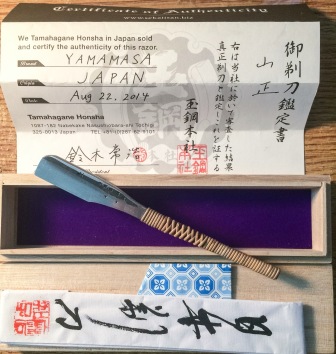
Just when you’ve seen it all, the world of wetshaving throws you another curve ball! What’s this weird looking razor you ask? It’s possibly the most “common” razor in the past 1000 years!
The Japanese “Kamisori” straight razor has its roots well in to the middle ages. Originally used to shave the heads of Buddhist monks out of respect for their religious beliefs, Kamisori eventually made its way through the different areas of Japan and eventually went to inspire the western style straight razor of the 17th and 18th centuries. Let’s go over the definition and some terms:
Definition:
Kamisori: Translated from Japanese = “razor”
That’s it. Kamisori merely means razor. This term is commonly used by westerners in reference to the traditional Japanese straight razor but does not carry the same meaning in Japan. Yes, you’re right. A Gillette Mach 3 is also a “Kamisori”.
What’s up with those parts?
Let’s take a look at the parts of a traditional Kamisori.
- Ura: hollow ground side (Side with the makers mark) faces away from your face when using in the traditional fashion
- Omote: slightly hollow side, goes against your facewhen using in the traditional fashion
- Rattan: traditional twine wrap that seals the handle and helps with grip
- Tosuke: which is a rubber cover that goes over the handle and also helps with grip
- Paulownia wood box: Traditional wood box used to house Kamisori
Kamisori are designed to be used with only one side but today it’s very common to see people shave with both the “ura” and “omote” sides. It’s all preference and whatever works for you is always the best way.
What’s it made of?
Most vintage and traditional Kamisori straight razors are composed of either a Japanese steel called “Yaksuki” traditional “Swedish steel”, or the ultra-rare “Tamahagane steel”.
“Yaksuri is a carbon based steel made strictly in Japan which is hard and difficult to hone. Most new Kamisori razors are made with Swedish steel which provides a superior edge and longevity. That brings us to “Tamahgane”. This type of steel requires a very unique skill to produce. Its iron based and was used to make samurai swords in addition to razors for many years.
Today only one manufacturer commercially makes Tamahagane steel based Kamisori. The company’s name is Iwasaki Kamisori.
How do I strop this?
Most users today use a traditional strop but the true way to strop a Kamisori is…………..drum roll please……………………PALM STROPPING!!!
Palm stropping you say???? Yes I meant what I said. The traditional way is to strop a kamisori is with your hand.
I’m not going to emphasize enough how much I don’t want you doing this!! Please remember that I have been doing this along time and I have experience in this area!! Check out this video of myself palm stropping my Kamisori . DO NOT TRY THIS AT HOME KIDS!!!
What’s up with the box?
Most kamisori straight razors come in a small wooden box. This box is made from Paulownia wood which is similar to balsa wood. Paulownia trees are grown in Japan and other parts of Asia. It is still common to find many kitchen knives and tools stored in these boxes.
Which side do I shave with?
Ok so I’m not going to spend too much time here. Traditionally you are only supposed to shave with the “ura side up” ……..
………. “A properly honed Kamisori will shave well with both sides!!!”
Personally, I use both sides when shaving and find it works just fine!!!!
How do I hone it?
The honing sequence gets a lot of debate. This is why I refer to honing as the “dark side” of wetshaving. It’s the most debated process of any skill I have ever learned.
Traditional straight razors are honed using a 1:1 ratio, meaning that each side gets equal amount of time on the stone. Kamisori however, are honed differently.
Let me be the first to say that there are many ways to skin a cat but only one outcome. Whatever way you decide to hone your razors to get a shave ready edge is success. Don’t be “bullied” by those guys on the forum. If you can shave with your edge then your good in my book. Honing a Kamisori requires a different ratio.
Some use a 10:1 (10 strokes omote to every one stroke ura) ratio. Using the razor in the traditional fashion requires a lot of time on the omote side thus justify the different grind and honing sequence. Others use 10:5, 10:3, 2:3….and so on.
Personally I like 2:3 ratio because I shave with both the omote and ura sides of the blade. There’s nothing wrong with that because my results work well for me. One thing is for sure… these razors really get sharp!!
So that’s it ladies and gents!! Hope you enjoyed the article.
Thanks for reading and as always…………..
SHAVE STRAIGHT ……….
……………………AND SHAVE SAFE!!!!!!!!

